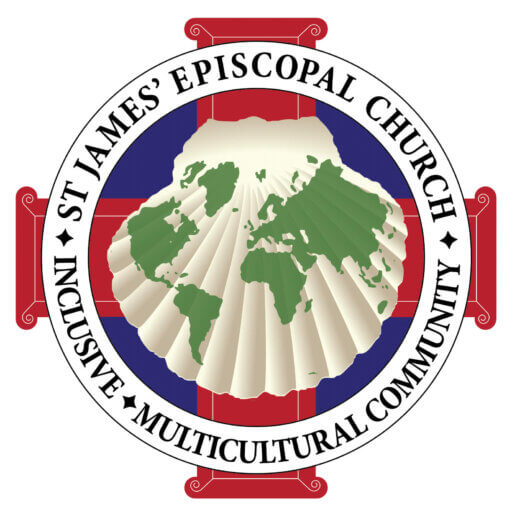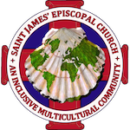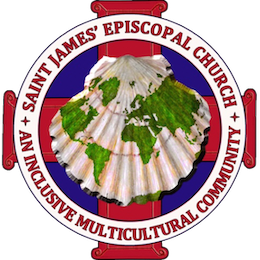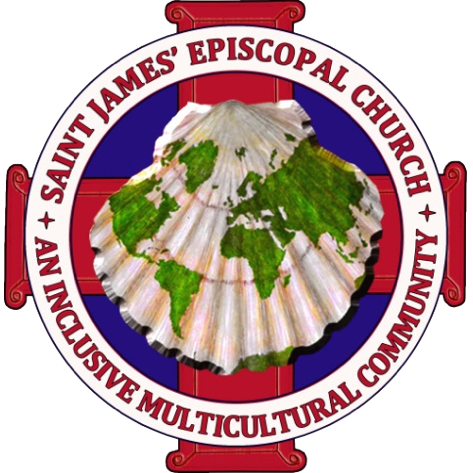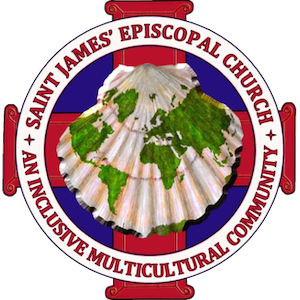Día de Los Muertos (Day of the Dead in English), is a special tradition of Mexican, northern Central American, and Mexican American heritage that is celebrated October 31st through November 2nd. St. James’ annual ofrenda (altar), installed by members of the 1 o’clock service and friends, is now up in the narthex. Día de Los Muertos is a way to remind us that even when someone has died, they are always with us.
During this season there are lots of skeletons and skulls everywhere—clothing, face painting, decorations, candy. Reassure little ones that there is nothing scary about this celebration. If you look closer, you may notice that many of skeletons look very familiar. Because, Día de los Muertos is when we get to remember and think about our favorite relatives who love us very much—like bisabuela (great grandma), bisabuelo (great grandpa), abuela (grandma) or abuelo (grandpa), tía (aunt) or tío (uncle), primos or primas (cousins), amigos (friends), and other familia (family) and members of la comunidad (the community) who have died. Some people even honor their old family pets, like their perro o gato (dog or cat). It is also a season for us to celebrate life, our journey, and the connection between the past and the present—Viva la Vida (Live Life). And those skeletons? They are often dressed, decorated, or adorned in ways that both honors and reminds us of our deceased loved ones. And if we’re lucky, their spirits may visit us during this special time of year.
The ofrenda (altar) at St James’ is intentionally multicultural, to reflect the diversity of our congregation. There is lots of symbolism on the ofrenda. The plaque commemorating our founders, the portrait of Rev. Martin Luther King, Jr, and the use of Black fabric symbolize our parish’s African American heritage. The colorful elements and various photos reflect our multicultural heritage. And of course, the altar itself as well as its many traditional elements reflect Mexican heritage and traditions, such as:
-
4 elements: water, wind, earth, and fire
-
Papel picado (elaborate cut paper)
-
Monarch butterflies
-
Flowers and marigolds
-
Calavera masks and sugar skulls
-
La Catrina (elegantly dressed lady)
-
Photos
-
Muñecas y juguetes (dolls and toys)
-
Food, such as pan de muertos (bread of the dead), water, drinks, and candy
All these decorations, beautiful smelling flowers, family favorites, and candles help light the way for spirits to find and visit their families. It’s a family reunion! And how do you welcome family when they’ve arrived for a visit after a very long journey? With food and drinks, of course!
Some ways you can embrace our St. James’ celebration:
-
Look at our ofrenda (altar). What symbols and imagery do you notice? Who are the people named or in the photos?
-
Bring a photo or a small special object of your loved one to place on the St. James’ altar (be sure to pick up your items when it’s time for the altar to come down).
-
Ask someone to share a story about one of their loved ones who has died. And share a memory with them of someone who is important to you. If you normally attend the 8am, 10:15am, or 5:30 pm service, attend the 1 o’clock Spanish language service at St James’ for a change one Sunday or two.
-
Visit a local Mexican bakery or treat shop to try some pan de muertos or a calavera (sugar skull), and other dulces (sweets).
-
Read a book, like The Dead Family Diaz by P.J. Bracegirdle, illustrated by Poly Bernatene, or Rosita y Conchita: A Rhyming Storybook in English and Spanish by Eric Gonzalez and Erich Haeger.
-
Participate in community celebrations, like the Viva la Vida parade and festival organized by the Mexic-Arte museum on October 26, the Día de Los Muertos celebration at the Mexican American Cultural Center (MACC) on November 2, or see the children’s play Rosita y Conchita at the Scottish Rite Theatre.
Written by Simone Monique Barnes, Director of Family Ministries
